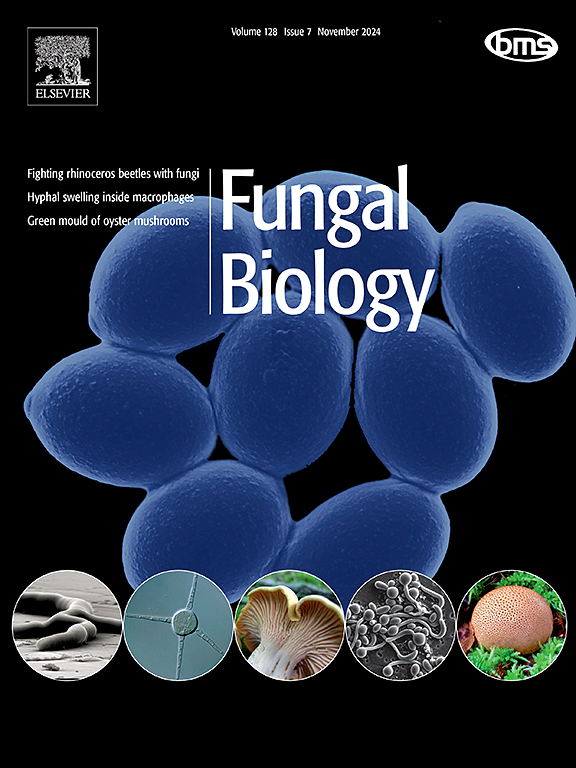放眼全球,放眼本地:9年的大型真菌取样揭示了佛罗里达州亚热带地区奥德韦-斯威舍生物站广泛的生物多样性
IF 3
3区 生物学
Q2 MYCOLOGY
引用次数: 0
摘要
奥德威-斯威舍生物站(OSBS)是一个38平方公里的保护区,归佛罗里达大学所有,是国家生态观测站网络(NEON)的一部分。该保护区包含几个标志性的佛罗里达栖息地,如沙丘,梅西克吊床,和灌木平坦的森林。虽然在OSBS对植物和动物进行了广泛的研究,但真菌仍然知之甚少。真菌清单对于增加对真菌多样性和物种范围的认识至关重要,从而为生态学和资源管理中的广泛应用提供基础数据。在这里,我们介绍了在OSBS收集,保存和DNA条形码的9年努力的结果。这项工作产生了1200个担保标本和984个ITS rDNA序列,代表了超过546个物种。我们的采样以担子菌科为主,并揭示了共生外生菌根真菌的高度多样性,特别是Amanita, Cortinarius和Russula。采样曲线和Chao1和Jacknife1丰富度估计表明,我们的DNA条形码工作只捕获了大约一半的大型真菌物种,更完整的清单将在OSBS检测到897-1177种大型真菌。我们的采样发现OSBS的大型真菌种类比保护区已知的脊椎动物物种数量要多,我们的估计也表明OSBS的大型真菌种类可能比植物物种更多。这项研究是NEON站点内第一个全面的大型真菌清单,强调了长期监测的重要性,以提供真菌多样性,群落结构,保护,生物地理和分类方面的新数据。本文章由计算机程序翻译,如有差异,请以英文原文为准。
Think globally, barcode locally: nine years of macrofungi sampling reveals extensive biodiversity at the ordway-swisher biological station, a subtropical site in Florida
The Ordway-Swisher Biological Station (OSBS) is a 38-km2 reserve owned by the University of Florida and is part of the National Ecological Observatory Network (NEON). The reserve contains several iconic Florida habitats, such as sandhill, mesic hammock, and scrubby flatwoods. While plants and animals have been extensively studied at OSBS, the fungi remain poorly known. Fungal inventories are critical to increase knowledge of both fungal diversity and species ranges, and thus to provide foundational data for a wide array of applications in ecology and resource management. Here, we present the results of a nine-year effort to collect, preserve, and DNA barcode the macrofungi at OSBS. This effort generated >1200 vouchered specimens and 984 ITS rDNA sequences, representing more than 546 species. Our sampling was dominated by Basidiomycota and revealed a high diversity of symbiotic ectomycorrhizal fungi, particularly species of Amanita, Cortinarius, and Russula. Sampling curves and both Chao1 and Jacknife1 richness estimators suggest that our DNA barcoding efforts captured only about half of the macrofungi species and that a more complete inventory would detect 897–1177 macrofungi species at OSBS. Our sampling found more species of macrofungi at OSBS than the known number of vertebrate animal species at the reserve and our estimates also suggest that there are likely more macrofungi species than plant species at OSBS. This study is the first comprehensive macrofungi inventory within a NEON site and highlights the importance of long-term monitoring to provide novel data on fungal diversity, community structure, conservation, biogeography, and taxonomy.
求助全文
通过发布文献求助,成功后即可免费获取论文全文。
去求助
来源期刊

Fungal biology
MYCOLOGY-
CiteScore
5.80
自引率
4.00%
发文量
80
审稿时长
49 days
期刊介绍:
Fungal Biology publishes original contributions in all fields of basic and applied research involving fungi and fungus-like organisms (including oomycetes and slime moulds). Areas of investigation include biodeterioration, biotechnology, cell and developmental biology, ecology, evolution, genetics, geomycology, medical mycology, mutualistic interactions (including lichens and mycorrhizas), physiology, plant pathology, secondary metabolites, and taxonomy and systematics. Submissions on experimental methods are also welcomed. Priority is given to contributions likely to be of interest to a wide international audience.
 求助内容:
求助内容: 应助结果提醒方式:
应助结果提醒方式:


